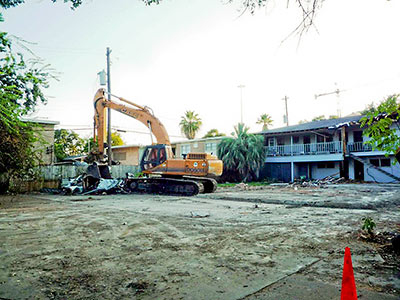
The 8-plex at 4725 Oakshire went down in a cloud of dust last week. “Bummer,” writes Jared Meadors, the landlord next door who bought and renovated the largely identical building at 4719 Oakshire 10 years ago. And who claims he “would have totally paid more than lot value for these and restored them as I did the units at 4719” if he’d had the chance. Meadors’s pinkish brick building to the west of the cleared lot is visible at the left of this photo:
***
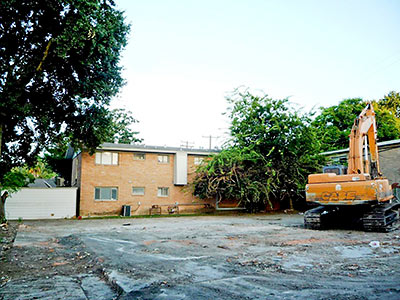
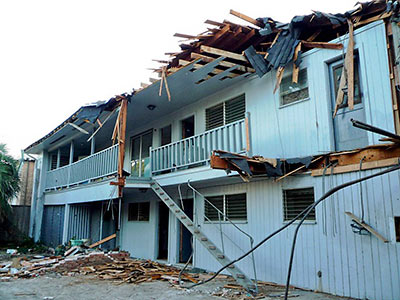
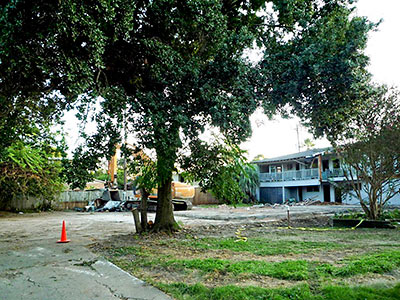
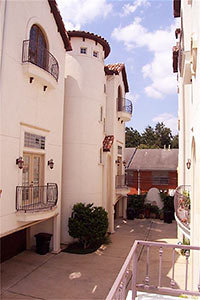 Meadors surveys the wreckage:
Meadors surveys the wreckage:
4710 sold a few years ago for $525,000. It was a big brick 4-plex on just over 5000 s.f. of land. They put up five 4-story, faux spanish style townhouses that did not sell for a long time. I think they started out in the $600,000 range and they ended up going back to the bank and are now selling in the high $300k / low $400k range.
I cringe to think what 4725 sold for (a) because it was probably not enough and (b) because my property value will probably go up significantly next year because of the sale. . . . But it sits on more land (over 8000 s.f.) so if the math is the same they’ll probably end up with more like 6 or more townhouses on that lot.
The reality that the developer of 4710 learned is that those two blocks are NOT Afton Oaks. Builders see stars when they try to use the big new houses selling one block away as comps for their development project — but it just doesn’t work like that. Will they make money? Sure, if they didn’t overpay for the lot and they don’t overbuild the townhouses and they don’t get stupid and ask $600,000 for a $400,000 townhouse — they should make money. And at the end of the day, that’s what it’s all about, right? I do what I do (buy, restore, and lease out) vintage properties because I get paid well to do it. If I didn’t, I wouldn’t.
More pix of Meadors’s surviving 8-plex:
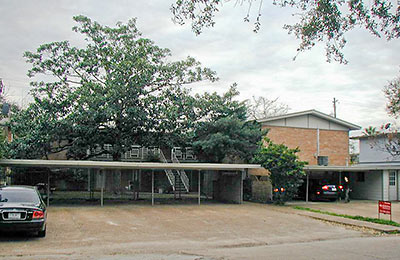
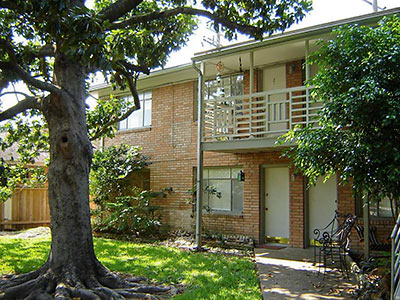
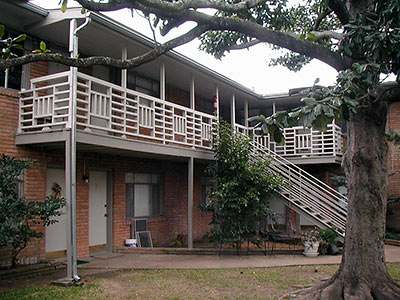
Photos: HAR (4710 Oakshire Dr.), Jared Meadors (all others)


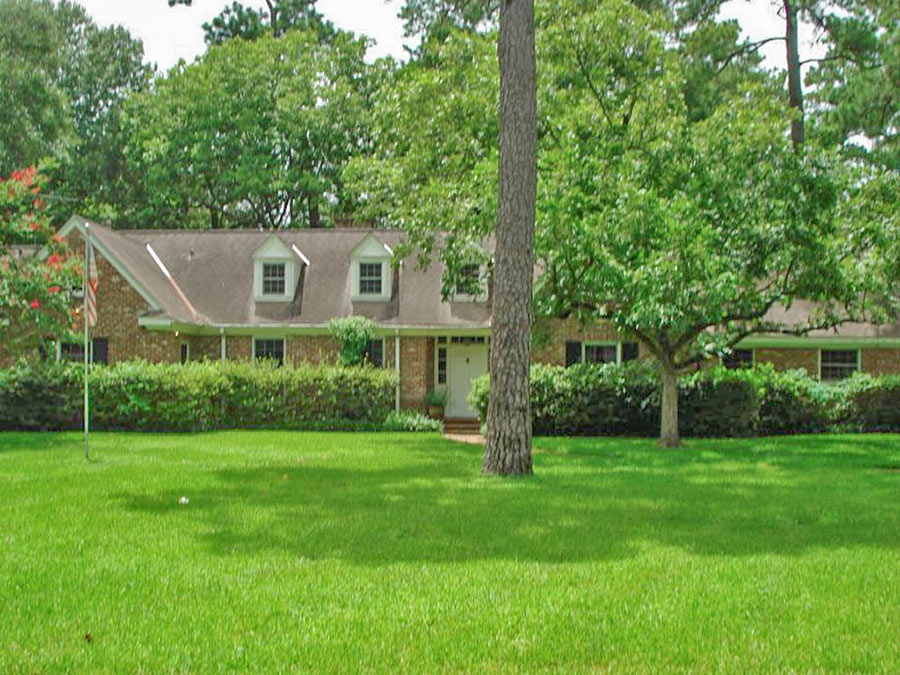

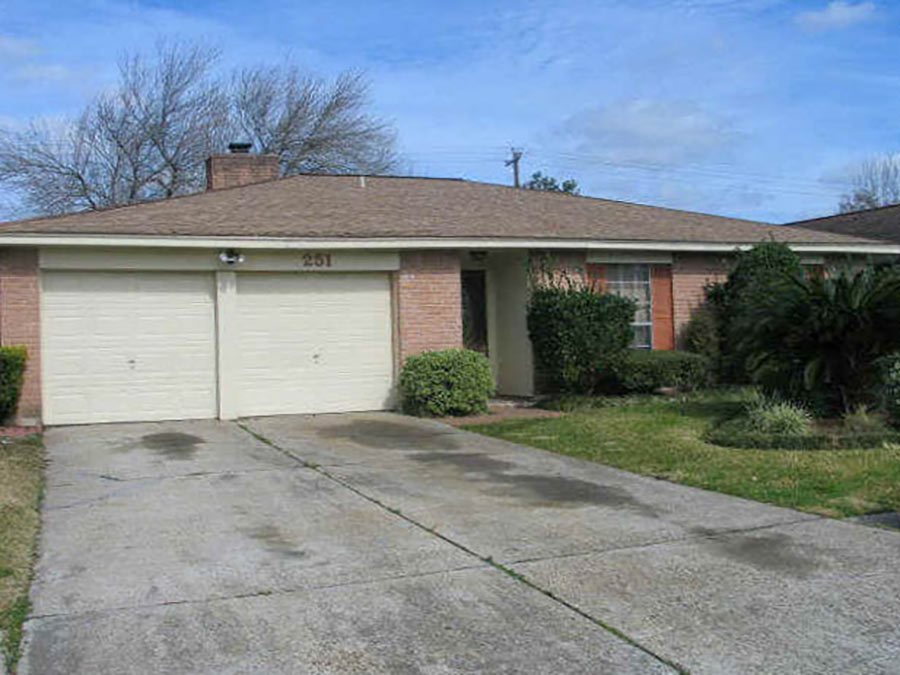
How about some color as to exactly why he didn’t buy it? Was he unaware that it was even for sale?
That is correct, Bernard. I wasn’t aware of the sale. I never saw a sign, the owner never contacted me to see if I might want to buy it, etc.
But that happens fairly often with commercial property; brokers don’t always put a sign up–particularly if they have a buyer already lined up.
One day the units were all full. The next day the building was empty and there were several red tags and permits up on the building. A few days later, the bulldozer showed up and laid waste to the buildings.
When I was young and single, I always looked for small, out of the way apartment complexes.
Lived in probably 5 or 6 between ’66 and ’79 and all but one inside the loop. Oh, and I forgot about Cummins Ln, that was with 3 room mates and did we have fun.
Still, I liked the smaller ones when living by myself. It felt more like ‘family’ somehow.
What a shame. As a former tenant of Jared’s in 4719, I would have loved to see him (or someone) be able to renovate the original building. Jared’s properties have such a good blend of historic charm and modern comforts, and we are getting more and more thin on those kinds of properties for renters in Houston. And we are definitely NOT lacking for “double-wide on the side mini-mansions”. I get that it’s about the bottom line for Jared or anyone else in business to make money. But for the multi-plex developers it’s done with such extremes that little is left but the dollar. Certainly not a respect for the history or personality of a place that had plenty of life left in it.
I lived there (4723/4725 Oakshire) for 10 years. The owner sent a letter saying that the fight to keep the inspectors happy was no longer worth it to him, and that’s why he sold.
This area adjacent to Afton Oaks is actually New Castle Courts and is a great pocket of multi-family centrally located off 610 loop across from the Galleria with easy access off of 610 or 59 by taking the Westheimer exit. It is ideal for the next waive of highrise living with an unobstructed view of the city.
We operate the Oakshire Manor next to the subject property at 4727 Oakshire Dr and have maintained the nostalgic feel with the tile and hardwood floors.
I applaud you, Jared, for saving and renovating these charming small properties. I lived in a Montrose 8-plex on Branard for 10 years. It was later purchased, and rather than tearing it down, the new owners converted it to a single family home, leaving the original footprint intact.
I now own a condo in a small 1956-era complex near Highland Village. After you’ve lived in one of these little gems, there’s no going back. It’s a shame they’re being torn down for characterless townhomes!
“glennaa: I lived there for 10 years. The owner sent a letter saying that the fight to keep the inspectors happy was no longer worth it to him, and that’s why he sold.”
.
Gus, please make this comment of the year. This is SPOT F’ING ON! It’s VERY VERY hard to keep some of these older properties alive. Owners that try hard and have good intentions and work to keep their properties updated get caught in the cross hairs of the cities battle against ‘slumlords’. They city has the power to (just about) force you to sell your place off by making it impossible to update.
.
I’ve said it here 100x; so often the properties that get knocked down that people get up in arms about are properties that are very hard to keep going the way the city works with owners.
In terms of dealing with the City and their new b.s. “Habitability” inspections–there is no doubt that I’m not a fan of that fee generating scam. But the reality is that there are a LOT of slumlords out there that don’t do their jobs and don’t keep up the buildings as they should. We had our initial inspection on the exterior of the units on Oakshire a couple of months ago and the only thing they red tagged me for–and this is a building from the 1950s–was a couple of small issues at the electrical panels. (No grounding rods–which was not required when the panels were originally installed–and there were a couple of empty spots / missing breakers in the panels–which, I guess if a tenant decided to go back behind the building, open the electrical panel, and stick their finger or a butter knife of something in that empty breaker slot–could be dangerous.
The total cost to resolve those issues will be under $500–1/2 of that being the electrical permit. Let’s say you have 8 units @ $800/month. That’s $6400 a month in rent. So, spending even $100/month on average to deal with the city / inspections / permits / licenses / etc–is not that big a deal from a financial standpoint–certainly not enough to warrant selling the building and / or tearing it down. So, that argument is ridiculous.
As a landlord, your costs go up every year. Property taxes. Insurance. City fees. Utilities. Maintenance. It’s called inflation and there’s no way around it. And that’s why we raise rents pretty much every year–to keep up with our rising costs. (I paid over $50,000 in property taxes alone this year–and 1/2 of that went to HISD.)
In the $100/mo scenario above–probably what the average small apartment owner will end up paying in additional extortion to the City of Houston for their new Habitability regulations–the landlord who just sold the property on Oakshire that was torn down would only have to raise his rents by $12.5/month to cover those costs. That’s it. And I’m pretty sure that most of those tenants who were evicted would have gladly paid another $12.50 to not have to move.
So, though certainly pesky, misguided, and unproductive, the Habitability permits / inspections were not the reason this building was torn down. That being said, it’s a free country (OK, it’s really not but you know what I mean), and I support any property owner’s right to do WHATEVER he or she wants to do with that property–so long as it is legal. And it is certainly legal to tear down a building.
Jared: You got lucky with that example (and FYI I do know your stuff to be very nice. Much higher level of upgraded units than what I do, so I’m only adding my $.02 as someone that’s had to deal with this a lot). But the small (normally older) independent owner with just one or two small properties often can’t deal with all that is required. In your case it was a grounding rod and new cover panel (we do that right after buying a place since we know that’s what they look for. And guess what? It’s $40 to fix it when I can just fix it. Or $500 if the city has a tag for it), but for others, it’s replacing all their railing because the pickets are 5 inches apart rather than 4 inches apart. Or redoing all their soffets because an inspector found them to be subpar.
.
And even though the work might be “easy”, it’s still time to find someone, then if a permit is involved, not only are the fees high, but the costs go way up by the contractor because of the time they need to get the permit and the fact they have to be licences and/or have their masters license (with the exception of structural). And nothing seems to go right the first time so they get taken by the workers, get fined by the city, have to go back and do paperwork, etc. Most of these older owners don’t have “guys” they can call on staff. They call 1-800-contractor out of the yellow pages and get jacked each time a little repair is needed.
.
3 of the last few properties I bought, were all sold to me because the people were getting tagged by the city (or fines for not registering their property with habitability). And these were older folks with good hearts and tenants that loved their units and the owner. Sure we came in and made them “nicer” and fixed the red tag issues, but say ‘bye bye’ to those $500/month 1 beds as now that their “fixed”, the new rent is $800.
.
I’m suuuure those tenants are stoked to have had all the issues fixed. Sure they had to move to the hood because they can’t afford $800 when they were paying $500, but at least their safe from 5 inch guard rail pickets and missing grounding rods!